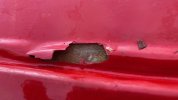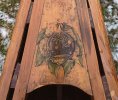Jörg
Curious about Wooden Canoes
Hello,
some weeks ago I was lucky to buy an old chestnut canoe in Germany.
I think it’s a cruiser and I want to restore it.
length 16'
max width (outside gunwales) ~83,5cm
it has tumblehome.
depth at midships ~32.5cm
stems ~59cm
decks are just 10cm wide, crowned and undercut.
ribs are ~58mm wide with a distance of ~50mm
planks ~70mm wide.
There is a shoe keel, which is attached on every rib.
The seats are mounted directly under the gunwales (just 1 position on the rear seat with short hangers).
Seats, thwarts and decks are maple (decks and only the bow seat are birdseye – I wonder if one of the seats is a replacement).
Gunwales could be spruce.
Keel and gunwales are attached with slotted screws (seem to be original).
The decal looks quite similar to the one in Grahams post from 2013 “old chestnut decal”
It's in quite good condition.
After cleaning the interior I found some older plank repairs don with kind of window putty.
Already started stripping the interior.
I would like to find out it’s approximate age … (?)
Jörg





(sorry for all the metric dimensions…)
some weeks ago I was lucky to buy an old chestnut canoe in Germany.
I think it’s a cruiser and I want to restore it.
length 16'
max width (outside gunwales) ~83,5cm
it has tumblehome.
depth at midships ~32.5cm
stems ~59cm
decks are just 10cm wide, crowned and undercut.
ribs are ~58mm wide with a distance of ~50mm
planks ~70mm wide.
There is a shoe keel, which is attached on every rib.
The seats are mounted directly under the gunwales (just 1 position on the rear seat with short hangers).
Seats, thwarts and decks are maple (decks and only the bow seat are birdseye – I wonder if one of the seats is a replacement).
Gunwales could be spruce.
Keel and gunwales are attached with slotted screws (seem to be original).
The decal looks quite similar to the one in Grahams post from 2013 “old chestnut decal”
It's in quite good condition.
After cleaning the interior I found some older plank repairs don with kind of window putty.
Already started stripping the interior.
I would like to find out it’s approximate age … (?)
Jörg
(sorry for all the metric dimensions…)




